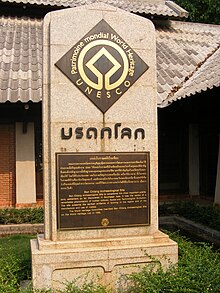Ban Chiang (archaeological site)
| UNESCO World Heritage Site | |
|---|---|
 |
|
| Location | Udon Thani, Thailand |
| Criteria | Cultural: iii |
| Reference | 575 |
| Inscription | 1992 (16th Session) |
| Area | 30 ha |
| Buffer zone | 760 ha |
| Coordinates | 17°24′25″N 103°14′29″E / 17.4069°N 103.2414°ECoordinates: 17°24′25″N 103°14′29″E / 17.4069°N 103.2414°E |
Ban Chiang (Thai: บ้านเชียง, pronounced [bâːn tɕʰīa̯ŋ]) is an archeological site in Nong Han District, Udon Thani Province, Thailand. It has been on the UNESCO world heritage list since 1992. Discovered in 1966, the site attracted enormous publicity due to its attractive red painted pottery.
Villagers had uncovered some of the pottery in prior years without insight into its age or historical importance. In August 1966 Steve Young, an anthropology and government student at Harvard College, was living in the village conducting interviews for his senior honors thesis. Young, a speaker of Thai, was familiar with the work of Wilhelm G. Solheim and his theory of possible ancient origins of civilization in Southeast Asia. One day while walking down a path in Ban Chiang with his assistant, an art teacher in the village school, Young tripped over a root of a kapok tree and fell on his face in the dirt path. Under him were the exposed tops of pottery jars of small and medium sizes. Young recognized that the firing techniques used to make the pots were very rudimentary, but that the designs applied to the surface of the vessels were unique and wonderful. He took samples of pots to Princess Phanthip Chumbote who had the private museum of Suan Pakkad in Bangkok and to Chin Yu Di of the Thai Government's Fine Arts Department Later, Elisabeth Lyons, an art historian on the staff of the Ford Foundation, sent sherds from Ban Chiang to the University of Pennsylvania for dating.
During the first formal scientific excavation in 1967, several skeletons, together with bronze grave gifts, were unearthed. Rice fragments have also been found, leading to the belief that the Bronze Age settlers were probably farmers. The site's oldest graves do not include bronze artifacts and are therefore from a Neolithic culture; the most recent graves date to the Iron Age. Pots and sherds from the site are now found in museums across the world, including the Museum für Indische Kunst in Berlin and the British Museum in London.
...
Wikipedia

